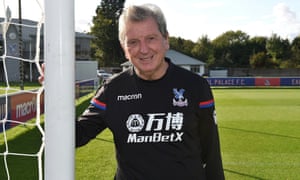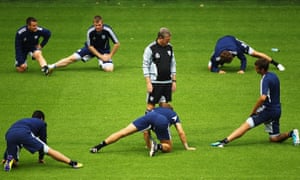
When West Bromwich Albion players think back to the early days under Roy Hodgson, the memories that stick in the mind are of the shift in the intensity of their work on the training ground, the way they returned to the dressing rooms exhausted, and how their new manager never missed a trick. “I can see you’re walking, you’re not doing it,” was one of Hodgson’s favourite phrases as he worked time and again on team shape.
Albion was Hodgson’s last job in club management, before he left to take the England position back in 2012, and the short but sweet spell that he spent in charge at the Hawthorns provides a reasonable barometer for what to expect at Crystal Palace, where the 70-year-old is working at a club operating at a similar level and faced with some of the same challenges that confronted him in the Midlands.
Then, much like now, Hodgson had a reputation to rebuild after lasting only six months as Liverpool manager. In another parallel between life at Selhurst Park and the Hawthorns, Hodgson took over a group of players at Albion that were crying out for leadership and a more pragmatic approach. Rudderless under Roberto Di Matteo, who ran a laid-back regime, Albion had lost 13 out of 18 matches and failed to keep a clean sheet for six months when Hodgson rocked up.
Albion turned to Hodgson because he was seen as a safe pair of hands who could give a struggling team some direction. The transfer window had closed, which meant that Di Matteo’s successor would have to make the the best of whatever he inherited, and Dan Ashworth, who was Albion’s technical director at the time, was confident that Hodgson would thrive in that situation because of his desire to be out on the training ground every day coaching.
Whatever anyone thinks of Hodgson, that sort of thing is his forte. “If there are problems in the team in terms of organisation and structure, Roy will get down to work at them straight away,” says Terry Burton, who worked alongside Keith Downing on the backroom staff at Albion and laughs as he recalls how the two of them were left “fighting to get the cones to put out” because Hodgson was so hands on.
With Hodgson at Albion, it was all about the players knowing their jobs with and without the ball and everything he did on the training field had that in mind. “Some people are session coaches and some are team coaches,” explains Burton. “Session coaches will put on a passing drill or a possession practice while team coaches will coach a function of the team, such as getting full-backs to support wide players or midfielders. And in terms of the team coaches I’ve worked with, I would put Roy at the top. He’s very good at getting players to understand their role within the team.”

Burton has not got a bad word to say about Hodgson and that kind of feedback is indicative of the way many people at Albion feel about a man who spent only 15 months in charge. It was interesting interviewing James Morrison a few years ago and hearing the Scotland international, who is not the sort of person to say things just for the sake of it, talk so highly of Hodgson.
Hodgson’s management style and way of working may not be to everyone’s liking, yet individually and collectively Albion’s players reaped the rewards of all the hours put in on the training ground, where near enough everything they did related to a game situation. There was a big emphasis on working on pattern of play in full-sided games, dividing the team into units in and out of possession, with no more than 10 core practises that Hodgson relied upon to get his points across, which inevitably meant a lot of repetition.“Roy was a special guy and he taught me a lot: how to play midfield on the defensive side – backing up play, shuffling across, blocking up lines. He was very interesting, like one of those experienced men you see in a pub sometimes who you can go to for a chat,” Morrison said. “Roy probably laid a lot of the foundations at West Brom. He’s a real good man and I’ve got a lot of respect for him.”
By the end of the sessions his squad were mentally as well as physically drained – “All the players came off the pitch sweating, thinking we’d never worked that hard before,” Morrison said – but they bought into what Hodgson was doing because they recognised the benefits. Albion picked up 20 points from 12 games under Hodgson in his first season in charge, climbing from 17th to 11th in the process. The following year they finished 10th.

An intelligent and well-read man, Hodgson was viewed at Albion as someone who was just as comfortable holding a conversation in the boardroom as he was talking through ideas to a right-back on the training pitch. He formed a strong relationship with Ashworth, who would later follow him to the Football Association, and the two worked closely on player recruitment. Not the sort to take a punt on a player whom he knew little about, Hodgson adopted a safe approach to transfers at Albion and preferred whenever possible to watch a target play live, travelling all over the country with Ashworth to give his verdict on a prospective signing.
Although staff and players found Hodgson’s enthusiasm infectious at Albion, especially when he set foot on the training ground, when there was a sense that he could not have been in a happier place (it is tempting to think he is much better suited to club rather than international management on that point alone), he also had an edge to him and was not afraid to light the fuse when things were not done right. There were no cups thrown in the dressing room but Hodgson got his point across to players passionately and forcefully when the need arose.
Generally, though, there were plenty of smiles during his time at the Hawthorns, where the level of expectation was nothing like as great as Liverpool, the media spotlight far less intense and the players receptive to his methods. Fast forward five or six years and Burton sees no reason to think why the same will not be true at Palace.
“Certain coaches fit certain clubs,” he adds. “And I think if you look at what Roy did at Fulham and West Brom, and you look at Palace and the type of coaches that they’ve had, from [Alan] Pardew to [Tony] Pulis and [Sam] Allardyce – and Roy would be above them for me in terms of his coaching ability – they all work at the fundamentals of the game. Roy, I think, will do a really good job at Palace. And I’m delighted for him, because I’d hate for his career to have been remembered for what happened with England last summer.”

No comments:
Post a Comment